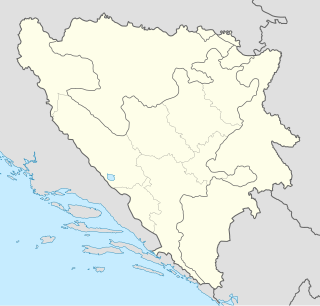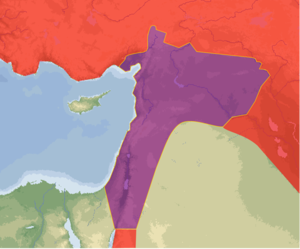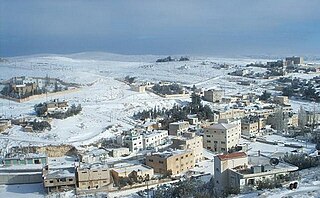
The Shimabara Rebellion also known as the Shimabara-Amakusa Rebellion was an uprising that occurred in the Shimabara Domain of the Tokugawa Shogunate in Japan from 17 December 1637 to 15 April 1638.

Velika Kladuša is a town and municipality located in Una-Sana Canton of the Federation of Bosnia and Herzegovina, an entity of Bosnia and Herzegovina. It is situated in the far northwest of Bosnia and Herzegovina, located near the border with Croatia. As of 2013, it has a population of 40,419 inhabitants.

Ma'an is a city in southern Jordan, 218 kilometres (135 mi) southwest of the capital Amman. It serves as the capital of the Ma'an Governorate. Its population is approximately 41,055 in 2015. Civilizations with the name of Ma'an have existed at least since the Nabatean period—the modern city is just northwest of the ancient town. The city is an important transport hub situated on the ancient King's Highway and also on the modern Desert Highway.

Ma'an is one of the governorates of Jordan, it is located south of Amman, Jordan's capital. Its capital is the city of Ma'an. This governorate is the largest in the kingdom of Jordan by area.
The Peasants' Revolt was a rebellion against Egyptian conscription and taxation policies in Palestine. While rebel ranks consisted mostly of the local peasantry, urban notables and Bedouin tribes also formed an integral part of the revolt, which was a collective reaction to Egypt's gradual elimination of the unofficial rights and privileges previously enjoyed by the various classes of society in the Levant under Ottoman rule.
The Albanian Revolt of 1847 was a 19th-century uprising in southern Albania directed against Ottoman Tanzimat reforms which started in 1839 and were gradually being put in action in the regions of Albania.
The Albanian revolts of 1833–1839 took place in Albania as a reaction against the new centralizing policy of Ottoman administration.
Adwan Rebellion or the Balqa Revolt was the largest uprising against the British mandate and the newly installed Transjordanian government, headed by Mezhar Ruslan, during its first years. The rebellion was initiated in the early months of 1923, under the slogan "Jordan for Jordanians", but was quickly crushed with the assistance of the British RAF. As a result, the revolt leader, Sultan al-Adwan, fled to Syria with his sons.

The Hauran Druze Rebellion was a violent Druze uprising against Ottoman authority in the Syrian province, which erupted in 1909. The rebellion was led by the al-Atrash family, in an aim to gain independence, but ended in brutal suppression of the Druze, significant depopulation of the Hauran region and execution of the Druze leaders.
The 1834 Hebron massacre occurred in early August 1834, when the forces of Ibrahim Pasha launched an assault against Hebron to crush the last pocket of significant resistance in Palestine during the Peasants' revolt in Palestine. After heavy street battles, the Egyptian Army defeated the rebels of Hebron, and afterward subjected Hebron's inhabitants to violence following the fall of the city. About 500 civilians and rebels were killed, while the Egyptian Army experienced 260 casualties.

Al-Mazraa, also known as as-Sijn is a village in southeastern Syria, administratively part of the as-Suwayda Governorate, located 12 kilometers northwest of as-Suwayda. Nearby localities include al-Hirak, Khirbet Ghazaleh and Da'el to the west and Umm Walad and Bosra to the south. According to the Syria Central Bureau of Statistics (CBS), al-Mazraa had a population of 2,596 in the 2004 census. The town is also the administrative center of the al-Mazraa nahiyah of the al-Suwayda District which consists of 12 villages with a combined population of 16,627.

Umm Walad is a town in southern Syria, administratively part of the Daraa Governorate, located east of Daraa in the Hauran region. Nearby localities include Ira to the southeast, Jabab to the south, al-Musayfirah to the southwest, al-Karak to the northwest, al-Thaalah to the north and al-Suwayda to the northeast. According to the Syria Central Bureau of Statistics (CBS), Umm Walad had a population of 7,547 in the 2004 census.
Husayn Pasha ibn Makki served as the Ottoman wali of Damascus (1757) and Marash (1762), and the sanjak-bey of his native Gaza (1763–1765).
The Naqib al-Ashraf revolt was a popular uprising in Jerusalem against the Ottoman authorities between May 1703 and October 1705. It was led by the city's naqib al-ashraf, Muhammad ibn Mustafa al-Husayni al-Wafa'i, and the rebels consisted of townspeople, peasants from nearby villages, local Bedouins, and religious notables (ulama). For over two years the rebels engaged in virtual self-rule in the city. However, divisions emerged within rebel ranks, and following an Ottoman siege, the rebel camp led by al-Husayni fled the city and were later captured and executed.

Urman is a village in southern Syria, administratively part of the Salkhad District of the al-Suwayda Governorate. It is located south of al-Suwayda and nearby localities include Salkhad to the west, Awas to the south, Malah to the east and Sahwat al-Khudr to the north. In the 2004 census it had a population of 5,735.

Siege of Al-Karak was a 17-day siege imposed by Ibrahim Pasha of Egypt on the Transjordanian town of Al-Karak in 1834. The Pasha laid the siege on the town in pursuit of Qasim al-Ahmad, the leader of the Peasants' revolt in Palestine, who had fled from Nablus to take shelter in Al-Karak.

The Karak revolt was an uprising against Ottoman authority in the Transjordanian town of Al-Karak, which erupted on 4 December 1910. The revolt came after Sami Pasha, the governor of Damascus, wanted to apply the same measures of conscription, taxation, and disarmament to the inhabitants of Al-Karak that previously provoked the Hauran Druze Rebellion.
The Syrian Peasant Revolt was an armed uprising of Arab peasant classes against the rule of Ibrahim Pasha of Egypt in 1834–35. The revolt took place in areas of Ottoman Syria, at the time ruled by the semi-independent ruler of Egypt, who conquered the region from loyal Ottoman forces in 1831.
















